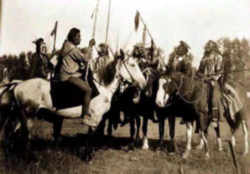


Louisiana Symbols
Louisiana Early History
First Early Inhabitants of Louisiana

Early history examines the archaeological record that tells the story of the first inhabitants of Louisiana. Learn about the history and culture of the first inhabitants, and what lessons it might teach us about the early history of Louisiana.
Louisiana First Early Inhabitants Timeline
- 40Mil BC - The whale species Basilosaurus (king lizard) isis was discovered in 1904. Paleontologists found bones of this creature in the 1830s in Louisiana. Fossils were found by U of Mich. paleontologist P.D. Gingerich in Egypt in 1989. With tiny hind limbs too weak to support its body on land, Gingerich believes it spent its entire life in the ocean. It reached about 40 feet. (LSA., p. 36)(PacDis, Winter/'96, p.15,16)
- 3,400 BC - An earthen mound at what later was known as Watson Brake, La. in the US was dated to this time. (SFC, 9/19/97, p.A3)
- 10,000 years ago - Earliest inhabitants of the area were probably nomads who hunted big game
- 6,000 years ago. - Tribes of the Muskhogean language family occupied the east-central and south-east region, Tunican tribes lived along the coast and in the northeast, and tribes of the Caddoan group inhabited the north and northwest.
- 2,000 years ago - Farming in the area
- 100BC - Organized farming in the Louisiana region began at this time with the cultivation of crops such as squash, sunflowers, beans and maize.
- 700 BC - Excavation at Poverty Point reveals that a highly organized society lived there
- 1519 - Alvarez de Pindea explores the mouth of the Mississippi
- 1541 - Hernando de Soto explores the Mississippi River
- 1682 - Robert Cavalier, Sieur de la Salle claims the territory for King Louis XIV of France and names the area La Louisianne after the French King
- 1700's - Chickasaw, Natchez and Yazoo warriors raiders attacked enemy tribes to capture slaves
Early History of Native Americans in Louisiana
The Indigenous People of Louisiana
The names of the Louisiana tribes included the Adai, Alabama or Alibamu, Apalachee, Muskogee Creek, Avoyel, Bayogoula, Tunica - Biloxi, Caddo, Chatot, Chawasha, Chitimacha, Choctaw, Houma, Koasati aka Coushatta, Koroa, Mugulasha, Atakapa, Natchez, Okelousa, Opelousa, Ouachita, Pascagoula, Quapaw, Quinipissa, Souchitioni, Tangipahoa, Tawasa were Muskhogean, Washa and Yatasi.
The Louisiana region was settled by Indians in prehistoric times, at least as early as 6,000 years ago. Tribes of the Muskhogean language family occupied the east-central and south-east region, Tunican tribes lived along the coast and in the northeast, and tribes of the Caddoan group inhabited the north and northwest.
The earliest inhabitants of the area we now call Louisiana were probably nomads who hunted big game as early as 10,000 years ago. Archaeologists
tell us that farming in the area began around 2,000 years ago with the cultivation of crops such as squash, sunflowers, beans and maize. Excavation
at Poverty Point reveals that a highly organized society lived there from around 700 BC
Groups of indigenous peoples lived and farmed in the area up until the arrival of Europeans in the 16th century. At the time of European exploration
in the 16th century, there were more than 10,000 Indians in Louisiana. By about 1700, there were probably as many as 15,000 Indians living in the area,
representing six different linguistic groups: the Caddo, the Natchez, the Atakapa, the Chitimachan, the Muskogean and the Tunican. Most tribes survived
on a combination of agriculture, hunting, and fishing. Usually, the men were responsible for ruling and defending the tribal community. They also constructed
the community's buildings and canoes, and hunted. Women cared for children and the elderly, planted crops and made clothes and utensils.
Clothing was often made of bark, hides, and feathers. Both men and women wore body ornaments like necklaces, armbands, rings, and ear and nose plugs
made from shells, pearls, and copper. Although religious practices differed from tribe to tribe, most Louisiana Indians believed that humans needed
to be in harmony with nature, and honored their dead with burial mounds, and celebrations of dance, song, and food. Natives lived and worshipped in
houses thatched with palmetto branches, or made of grass or traditional wattle and daub.
Native people also enjoyed themselves with various games and sporting events like wrestling, foot races, archery, dice, dancing and music.





